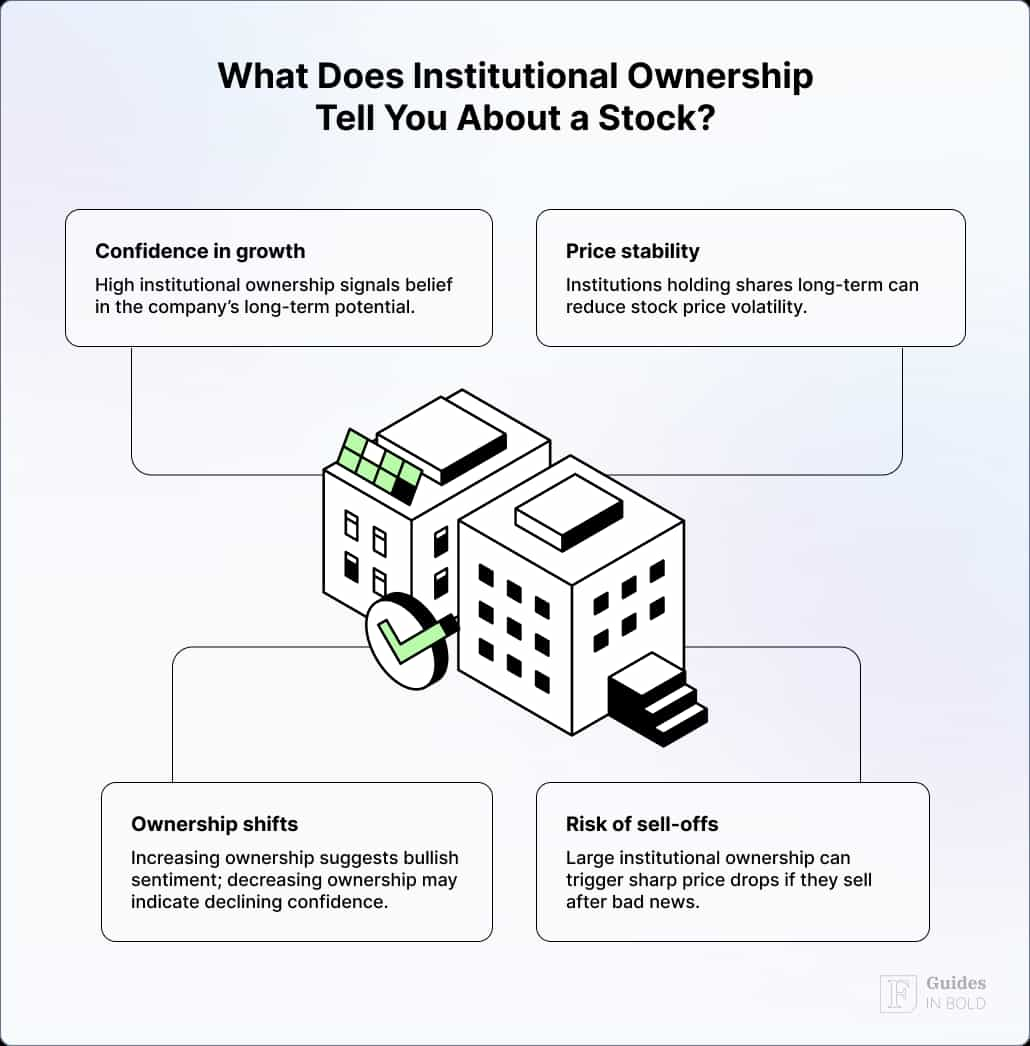If you’re wondering what institutional ownership tells about a stock and how you can use this information to improve your investing decisions, you’re in the right place.
Namely, institutional ownership refers to the percentage of a company’s shares held by large organizations, such as mutual funds, hedge funds, pension funds, insurance companies, endowments and foundations, and exchange-traded funds (ETFs).
This metric plays a crucial role in evaluating a stock’s performance and potential. Many investors keep a close eye on it, believing that institutions, with their vast research and resources, make better investment decisions than individual retail investors.
Institutional ownership explained
Because institutions have access to advanced research, complex financial models, and skilled analyst teams, their investments are often viewed as strong endorsements of a company’s potential.
In short, when institutions accumulate shares in a company, they may see strong growth potential or solid fundamentals that make it an attractive investment.
Here’s what institutional ownership can reveal about a stock:

- Confidence in a company’s growth potential: High institutional ownership can indicate that big players believe in the company’s future prospects. Since institutional investors typically hold large amounts of money, they carefully choose stocks that have the potential for steady growth or are undervalued compared to their true worth;
- Stock price stability: Large institutional ownership can help stabilize a stock’s price. Institutions tend to hold on to their shares for the long term, reducing volatility in the stock market caused by frequent buying and selling from individual retail investors;
- Risk of sudden sell-offs: On the flip side, when many institutions hold a stock, there’s a risk that they might sell off their shares if the company experiences poor earnings or bad news. This could lead to a sharp decline in the stock’s price since institutional investors control significant portions of shares;
- Changes in ownership patterns: If institutional ownership increases, it could signal that large investors are bullish on the stock. A decline in institutional ownership might suggest the opposite, that they are losing faith in the company’s performance or future prospects.
Is institutional ownership good for a stock?
When assessing whether institutional ownership is good for a stock, it’s key to examine more than just the raw percentage of shares owned. You should consider:
- Type of institution: Different institutions have varying investment styles and risk appetites. For example, a hedge fund may take riskier bets on a company, while a pension fund might look for safe, long-term growth. Understanding the type of institution involved gives you more context on the stock’s potential behavior;
- Recent activity: Are institutions buying more shares or selling? An increase in institutional ownership over time may signal rising confidence, while a reduction might indicate concerns;
- Concentration: If only a few institutions own most of the shares, this could indicate potential risks, such as price manipulation or a sudden drop in value if they all sell at once.
How institutional ownership affects stock performance
In essence, institutional investors influence stock prices with their buying and selling decisions. If they start acquiring shares in a particular stock, the price often increases due to high demand. At the same time, if they start selling, the price might drop.
Here’s how institutional ownership impacts stock performance:
- Liquidity: When institutions buy shares, they increase liquidity, which makes it easier for others to trade the stock. In general, higher liquidity lowers transaction costs and reduces price volatility;
- Volatility: Stocks with high institutional ownership tend to be less volatile. However, a sudden sell-off by these institutions can lead to quick price drops, especially if the institutions own large chunks of the stock;
- Market sentiment: Institutions can create trends. When they start investing in a stock, retail investors typically follow, driving prices up further. Similarly, if institutions lose interest, retail investors may panic and sell as well.
A 2006 study by Xavier Gabaix, Parameswaran Gopikrishnan, Vasiliki Plerou, and H. Eugene Stanley explored how institutional investors impact stock market volatility. The study found that institutional trades, especially in illiquid markets, can create extreme price fluctuations due to the sheer size of their transactions.
“The trades of large institutional investors in illiquid markets explain many patterns in the extreme behavior of returns and trading volume.” — Gabaix, Gopikrishnan, Plerou, and Stanley
Pros and cons of high institutional ownership

Pros
- More stable stock prices: With big players holding large portions of shares, a stock can become less susceptible to wild price swings;
- Confidence in the stock: Institutional investors, backed by research and resources, will likely choose stocks with strong growth potential.

Cons
- Institutional influence: Large institutions have the power to sway stock prices. A sudden sell-off can lead to a sharp drop in value;
- Reduced retail influence: In stocks with high institutional ownership, individual retail investors might have less sway in voting matters or corporate decisions.
Key takeaways on institutional ownership
Institutional investors play a critical role in both stabilizing and destabilizing stocks through their trading patterns. Their tendency to take a long-term investment approach can help reduce volatility, as they typically hold onto shares rather than frequently trading them.
However, when institutional investors decide to exit a position, they can do so swiftly, which may lead to significant price fluctuations. So, by actively monitoring trends in institutional ownership, investors can gain valuable insights into potential stock movements and make more informed decisions.
| Factor | High institutional ownership | Low institutional ownership |
| Price stability | High | Low |
| Volatility | Low | High |
| Liquidity | High | Low |
| Influence on corporate governance | High | Low |
| Risk of sudden sell-off | Moderate to high | Low |
Tools for tracking institutional ownership
If you want to track institutional investing, various tools can help you monitor which stocks institutions are buying or selling. One of these is Finbold Signals, which offers real-time updates on institutional trading via email, Telegram, and Discord.
Another solid way to track institutional investing is to follow the NASDAQ website, which offers free insights into the ownership percentages of top institutional investors.
How insider trading complements institutional ownership

Insider trading involves the buying or selling of a company’s stock by its executives, directors, or key employees. When these individuals purchase shares, it can signal confidence in the company’s future prospects, much like institutional investors.
On the other hand, if insiders are selling significant portions of their holdings, it might raise concerns about the company’s performance or future.
Recommended video: What is Insider Trading? Explained in 2 Minutes
Both institutional ownership and insider trading trends can give individual investors valuable clues about a stock’s potential direction. Therefore, monitoring both can provide a more comprehensive understanding of market sentiment.
The bottom line
Institutional ownership can offer great insights into the stock market and individual companies. For instance, high ownership can indicate stability and confidence in a company’s future, but it also comes with risks if these big players decide to sell.
So, by keeping an eye on institutional activity, retail investors can better anticipate stock movements and adjust their investment strategy accordingly. Furthermore, tools like Finbold Signals provide up-to-date info on institutional trading patterns, which, in turn, further provides a significant advantage in navigating the stock market.
Disclaimer: The content on this site should not be considered investment advice. Investing is speculative. When investing, your capital is at risk.
FAQs
What does institutional ownership tell you about a stock?
Institutional ownership indicates the confidence of large investors in a stock. High ownership can signal strong growth potential and stability, while low ownership might suggest more volatility or risk.
Is institutional ownership good for a stock?
Yes, high institutional ownership is good for a stock, as it often stabilizes a stock’s price due to long-term holding by institutions. It reflects a level of confidence in the company’s fundamentals and growth prospects.
Can institutional ownership influence stock prices?
Yes, large-scale buying by institutions can drive stock prices up, while a sudden sell-off can lead to sharp declines, especially if institutions control a significant portion of shares.
Where can I find institutional ownership of stocks?
You can use tools like Finbold Signals for real-time updates on institutional buying and selling. Other options include Morningstar and NASDAQ’s ownership reports.
Are there issues with high institutional ownership?
While high ownership can mean stability, the risk lies in the potential for sudden sell-offs, which could cause a rapid drop in the stock’s price.
What is institutional ownership?
Institutional ownership is the percentage of a company’s shares held by large organizations, like mutual funds, hedge funds, pension funds, insurance companies, endowments and foundations, and exchange-traded funds (ETFs).
What is a good percentage of institutional ownership?
A good range is typically between 50-70%, indicating institutional confidence without over-concentration, though this can vary by industry.
What are some stocks with low institutional ownership?
Smaller or newer companies often have low institutional ownership, such as small-cap stocks or niche sector stocks with limited market interest.
What are some stock with stocks with high institutional ownership?
Major companies like Apple (NASDAQ: AAP), Amazon (NASDAQ: AMZN), Microsoft (NASDAQ: MSFT), and Alphabet (NASDAQ: GOOGL) often have high institutional ownership due to their stability and growth potential.
What does it mean if institutional ownership is over 100%?
Over 100% ownership usually results from short-selling, where borrowed shares are sold with the intent of buying them back later, adding to total shares owned.
What are the benefits of institutional ownership?
High institutional ownership can lead to greater price stability, increased liquidity, and confidence in a company’s fundamentals.
What is common institutional ownership?
Common institutional ownership refers to multiple institutions holding shares in the same company, typically signifying broad confidence among professional investors.
How do you calculate institutional ownership?
Institutional ownership is calculated by dividing the number of shares held by institutions by the total outstanding shares, then multiplying by 100 to get a percentage.




